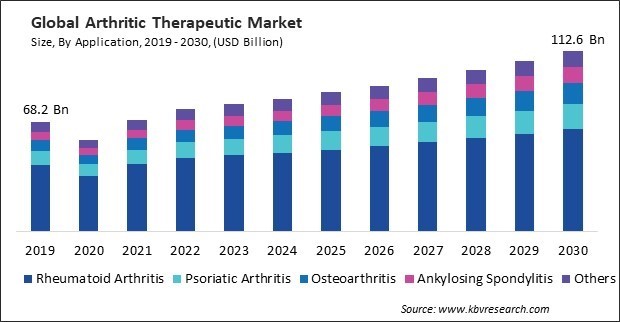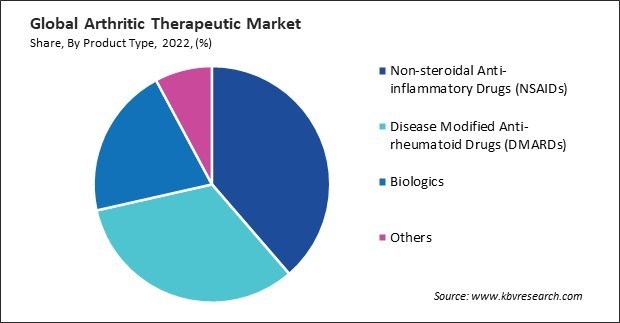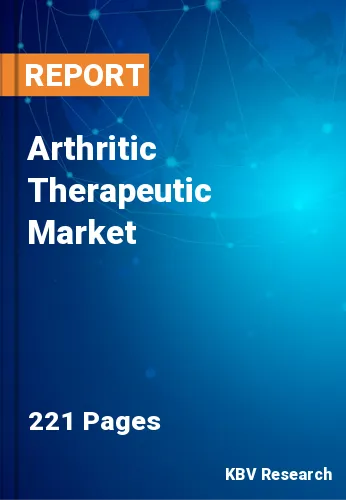“Global Arthritic Therapeutic Market to reach a market value of USD 112.6 Billion by 2030 growing at a CAGR of 5.1%”
The Global Arthritic Therapeutic Market size is expected to reach $112.6 billion by 2030, rising at a market growth of 5.1% CAGR during the forecast period.
The osteoarthritis segment encompasses a diverse array of treatment modalities, including pharmacological interventions, non-pharmacological therapies, and surgical interventions. Therefore, the osteoarthritis segment captured $7,913.2 million revenue in the market in 2022. Pharmaceutical companies develop and market a range of medications for osteoarthritis, including analgesics, nonsteroidal anti-inflammatory drugs (NSAIDs), corticosteroids, and viscosupplementation agents, to provide symptom relief and improve joint function.

As the prevalence of arthritis continues to rise globally, there is a growing population of individuals affected by the disease. This expanding patient population creates a larger market for arthritis therapies, including pharmacological interventions, non-pharmacological treatments, surgical procedures, and assistive devices, driving demand for arthritis treatments, and supporting market growth. Therefore, the market is expanding significantly due to the growing prevalence of arthritis.
Additionally, complementary and alternative therapies encompass various treatment modalities, including acupuncture, massage therapy, yoga, tai chi, dietary supplements, herbal remedies, and mind-body techniques. Thus, because of the rising focus on complementary and alternative therapies, the market is anticipated to increase significantly.
However, The high cost of arthritis therapeutics places a substantial financial burden on patients, particularly those without adequate insurance coverage or limited financial resources. The financial burden of arthritis management can contribute to medication rationing, skipping doses, or preceding necessary medical interventions, ultimately compromising treatment efficacy and patient outcomes. Thus, high cost can slow down the growth of the market.
The COVID-19 pandemic disrupted routine healthcare services, including outpatient visits, elective procedures, and non-urgent medical appointments, leading to delays in arthritis diagnosis, treatment initiation, and disease monitoring. The COVID-19 pandemic disrupted global drug supply chains, leading to shortages, stockouts, and delays in the availability of certain arthritic medications, including biologic therapies and specialty drugs. Thus, the COVID-19 pandemic had a moderate effect on the market.
By product type, the market is categorized into non-steroidal anti-inflammatory drugs (NSAIDs), disease modified anti-rheumatoid drugs (DMARDs), biologics, and others. In 2022, the non-steroidal anti-inflammatory drugs (NSAIDs) segment held 38.7% revenue share in the market. NSAIDs are instrumental in managing various symptoms associated with arthritis, including pain, swelling, stiffness, and functional impairment.

Based on application, the market is classified into rheumatoid arthritis, osteoarthritis, psoriatic arthritis, ankylosing spondylitis, and others. The psoriatic arthritis segment acquired 12.9% revenue share in the market in 2022. Psoriatic arthritis represents a significant unmet medical need, as it affects individuals with psoriasis, a common skin condition, and can lead to progressive joint damage, disability, and impaired quality of life if left untreated.
Free Valuable Insights: Global Arthritic Therapeutic Market size to reach USD 112.6 Billion by 2030
Region-wise, the market is analysed across North America, Europe, Asia Pacific, and LAMEA. In 2022, the Asia Pacific region acquired 23.4% revenue share in the market. Urbanization and lifestyle changes in the Asia Pacific region, including sedentary lifestyles, unhealthy diets, obesity, and physical inactivity, contribute to the rising prevalence of arthritis.
| Report Attribute | Details |
|---|---|
| Market size value in 2022 | USD 76.2 Billion |
| Market size forecast in 2030 | USD 112.6 Billion |
| Base Year | 2022 |
| Historical Period | 2019 to 2021 |
| Forecast Period | 2023 to 2030 |
| Revenue Growth Rate | CAGR of 5.1% from 2023 to 2030 |
| Number of Pages | 221 |
| Number of Tables | 290 |
| Report coverage | Market Trends, Revenue Estimation and Forecast, Segmentation Analysis, Regional and Country Breakdown, Porter’s 5 Forces Analysis, Company Profiling, Companies Strategic Developments, SWOT Analysis, Winning Imperatives |
| Segments covered | Product Type, Application, Region |
| Country scope |
|
| Companies Included | AbbVie, Inc., Pfizer, Inc., Amgen, Inc., Novartis AG, F. Hoffmann-La Roche Ltd., Viatris, Inc., Bausch Health Companies, Inc., Sanofi S.A., Merck & Co., Inc., Bristol-Myers Squibb Company |
By Application
By Product Type
By Geography
The Market size is projected to reach USD $112.6 billion by 2030.
Increasing number of senior citizens are driving the Market in coming years, however, Disease complexity and heterogeneity restraints the growth of the Market.
AbbVie, Inc., Pfizer, Inc., Amgen, Inc., Novartis AG, F. Hoffmann-La Roche Ltd., Viatris, Inc., Bausch Health Companies, Inc., Sanofi S.A., Merck & Co., Inc., Bristol-Myers Squibb Company
The expected CAGR of this Market is 5.1% from 2023 to 2030.
The Rheumatoid Arthritis segment is generating highest revenue in the Market, by Application in 2022; thereby, achieving a market value of $63.7 Billion by 2030.
The North America region dominated the Market, by Region in 2022, and would continue to be a dominant market till 2030; thereby, achieving a market value of $43.7 Billion by 2030.
Our team of dedicated experts can provide you with attractive expansion opportunities for your business.

 Drivers
Drivers
 Restraints
Restraints
 Opportunities
Opportunities
 Challenges
Challenges
